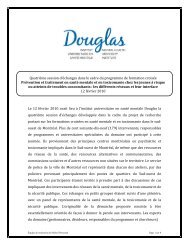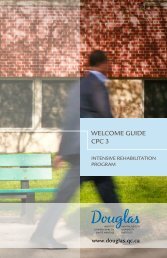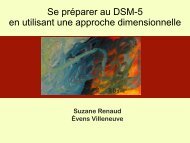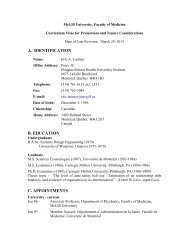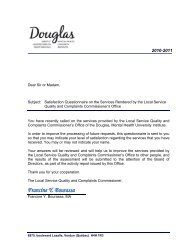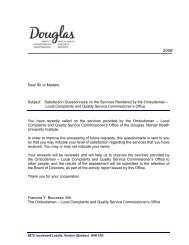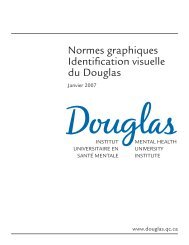Chapter 3S<strong>in</strong>gle-parent families are more common <strong>in</strong> <strong>Aborig<strong>in</strong>al</strong> communities than <strong>in</strong> the general population. In2001, about 35 per cent of <strong>Aborig<strong>in</strong>al</strong> children liv<strong>in</strong>g on reserves lived with only one parent, comparedto 17 per cent of non-<strong>Aborig<strong>in</strong>al</strong> children (Statistics <strong>Canada</strong>, 2003). However, the impact of s<strong>in</strong>gleparenthood depends on local social and cultural factors that determ<strong>in</strong>e the degree of support by extendedfamily, relatives, elders, and other members of the community. In some <strong>Aborig<strong>in</strong>al</strong> communities—notablythe Inuit—adoption may be extremely common and less stigmatized, and so may not be associated withthe same <strong>in</strong>creased risk for suicide seen <strong>in</strong> the total population.Studies among American Pla<strong>in</strong>s Indians found that youths who died by suicide were much more likelyto have had a change of caretaker dur<strong>in</strong>g their childhood or adolescence (May and Dizmang, 1974;Resnick and Dizmang, 1971). As discussed <strong>in</strong> detail <strong>in</strong> Chapter 4 of this report, <strong>Aborig<strong>in</strong>al</strong> populationshave experienced a high frequency of separations due to education <strong>in</strong> board<strong>in</strong>g schools and prolongedhospitalization out of their communities for tuberculosis and other chronic illness (Dickason, 1992;Kle<strong>in</strong>feld and Bloom, 1977; Manson et al., 1989). The residential school system exposed <strong>Aborig<strong>in</strong>al</strong>children to prolonged separations from family and k<strong>in</strong>, physical and sexual abuse, and active suppressionof their language and cultural identity (Coleman, 1993; Haig-Brown, 1990; Knockwood, 1992;Lomawaima, 1993).Childhood Physical and Sexual AbuseCl<strong>in</strong>ical and population studies support an association between a childhood history of physical and sexualabuse and later suicidal ideation and behaviour (Cleary, 2000; Dieserud et al., 2002; Evans, Hawton, andRodham, 2005a; Santa M<strong>in</strong>a and Gallop, 1998). An association of childhood physical abuse with suicidehas been found for adolescents <strong>in</strong> both case-control (Brent et al., 1999) and prospective longitud<strong>in</strong>al studies(Brown et al., 1999; Johnson et al., 2002). Most research on the association of childhood sexual abusewith suicidality has <strong>in</strong>volved cl<strong>in</strong>ical studies, which <strong>in</strong>troduce biases both because of the limitations ofretrospective recall and because cl<strong>in</strong>ical samples do not <strong>in</strong>clude people with a history of abuse who have notsought mental health services (Rogers, 2003). The most recent studies <strong>in</strong> the general population, however,have found a significant relationship between childhood sexual abuse and later suicidality (Fergusson et al.,2000; Molnar et al., 2001; Goldsmith et al., 2002; Evans, Hawton, and Rodham, 2005a). Although sexualabuse is more common among females, it may have an especially strong association with suicidality for males(Evans, Middleton, and Gunnel, 2004). Abused children are more likely than non-abused children to belater victims of abuse or to become sexual aggressors themselves. Thus, there seems to be a transgenerationalpattern of repetition of sexual abuse.Factors associated with risk of sexual abuse for a child <strong>in</strong>clude the family’s socio-economic status, change<strong>in</strong> family composition, difficulty <strong>in</strong> communication and attachment between the child and parent, parents’crim<strong>in</strong>al behaviour, substance/alcohol abuse, and psychological disorders. <strong>Aborig<strong>in</strong>al</strong> youth <strong>in</strong> <strong>Canada</strong> aremore likely than non-<strong>Aborig<strong>in</strong>al</strong> youth to witness family violence and to be subjected to physical and sexualabuse (Fischler, 1985; Lujan et al., 1989; MacMillan et al., 1996). Approximately one-half of <strong>Aborig<strong>in</strong>al</strong>children witnessed family violence, and the majority were female victims; 57% of <strong>Aborig<strong>in</strong>al</strong> women reportedthat their children had witnessed the violence compared to 46% of non-<strong>Aborig<strong>in</strong>al</strong> women (Tra<strong>in</strong>or andMihorean, 2001). The 1997 First Nations and Inuit Regional Longitud<strong>in</strong>al Health Survey <strong>in</strong> Ontario foundthat 59 per cent of First Nation adults had experienced physical abuse dur<strong>in</strong>g their childhood and 34 percent had suffered sexual abuse. The same survey found rates of sexual abuse among youth—14 per cent forboys and 28 per cent for girls (First Nations Centre, 2004). Urban <strong>Aborig<strong>in</strong>al</strong> people also experience high43
Chapter 3rates of physical and sexual abuse and violence, especially those who endure homelessness and prostitution(Farley, Lynne, and Cotton, 2005).In studies of the general population, the type and severity of abuse and the relation of the perpetratorto the child affect the impact of abuse on mental health (F<strong>in</strong>kelhor, 1995). Multiple, repeated exposuresto different forms of trauma and abuse have a cumulative effect caus<strong>in</strong>g more severe outcomes (Turner,F<strong>in</strong>kelhor, and Ormrod, 2006). Some of the effects of childhood abuse on suicide is due to the presence ofpsychiatric disorders like depression, but abuse may contribute to suicide even <strong>in</strong> the absence of obviouspsychiatric disorders. However, a study by Brent and colleagues (2002) suggests that childhood sexualabuse is associated with additional risk for suicide even <strong>in</strong> very high-risk groups, such as the offspr<strong>in</strong>g ofparents with mood disorders that made suicide attempts.Research that exam<strong>in</strong>es this l<strong>in</strong>k <strong>in</strong> <strong>Aborig<strong>in</strong>al</strong> populations is sparse. Prevalence rates of child abusewith<strong>in</strong> the <strong>Aborig<strong>in</strong>al</strong> population vary widely and there is no consensus on whether or not the ratesexceed those of the general population. In most recent studies, rates of abuse range widely from 12 percent <strong>in</strong> women and 2 per cent <strong>in</strong> men (rates comparable to those found <strong>in</strong> the general population <strong>in</strong> theU.S. National Comorbidity Study) to 50 per cent of women and 14 per cent of men (which are higherbut still comparable to rates reported <strong>in</strong> some general population studies) (Molnar et al., 2001; Rob<strong>in</strong> etal., 1997; Grossman et al., 1991; Hobfoll et al., 2002; Manson et al., 2005). This variation reflects genu<strong>in</strong>edifferences across communities and also the differ<strong>in</strong>g methods of data collection. As most studies relyon self-report, it is possible that these numbers are under-representations. The close <strong>in</strong>terpersonal andfamily ties <strong>in</strong> some communities may make disclosure less likely, and reluctance to make one’s communitylook bad might discourage report<strong>in</strong>g of abuse to outsiders (Rob<strong>in</strong> et al., 1997).Despite <strong>in</strong>dications of high rates of exposure to childhood physical and sexual abuse <strong>in</strong> the <strong>Aborig<strong>in</strong>al</strong>population, there has been little systematic <strong>in</strong>vestigation of the effects of childhood abuse specific tothis population (Rob<strong>in</strong> et al., 1997). The few relevant studies have shown behavioural and psychologicaleffects similar to those documented <strong>in</strong> the general population studies, <strong>in</strong>clud<strong>in</strong>g suicide attempts as well as<strong>in</strong>creased rates of depression, substance use, and anxiety disorders—conditions which <strong>in</strong>crease the risk ofsuicidal behaviour (Rob<strong>in</strong> et al., 1997; Pharris, Resnick, and Blum, 1997). Two studies found childhoodphysical (but not sexual) abuse to be related to later depression (Roosa et al., 1999; Hobfoll et al., 2002).There has been some study of factors contribut<strong>in</strong>g to resilience <strong>in</strong> abused <strong>Aborig<strong>in</strong>al</strong> <strong>in</strong>dividuals. Pharris andcolleagues (1997) found that perceived attention and car<strong>in</strong>g from family and other adults were associatedwith the absence of suicidal ideation and attempts among American Indian and Alaska Native youth with ahistory of sexual abuse. Hobfoll and colleagues (2002) suggest that social support may have a more positiveeffect on <strong>Aborig<strong>in</strong>al</strong> victims of abuse because of the central role of family and community <strong>in</strong> <strong>Aborig<strong>in</strong>al</strong>cultures.Further studies clarify<strong>in</strong>g the complex mean<strong>in</strong>gs and social context of abuse <strong>in</strong> <strong>Aborig<strong>in</strong>al</strong> communities areneeded. Ow<strong>in</strong>g to their geographic isolation and complex web of family relations, it may be exceptionallydifficult for <strong>in</strong>dividuals to disclose and confront family violence and abuse. This might <strong>in</strong>crease the feel<strong>in</strong>gof be<strong>in</strong>g trapped and so contribute to suicide.44
- Page 1 and 2:
Suicide Among Aboriginal Peoplein C
- Page 3 and 4:
Aboriginal Healing Foundation75 Alb
- Page 6 and 7:
Table of ContentsPreface...........
- Page 8 and 9:
Table of ContentsCultural and Lingu
- Page 10: PrefaceThis report was prepared und
- Page 14 and 15: GlossaryAmbivalence - Ambivalence r
- Page 16 and 17: GlossaryParasuicide - Any acute, in
- Page 18 and 19: Chapter 1IntroductionWhen I was 14
- Page 20 and 21: Chapter 1Definitions of Suicide and
- Page 22 and 23: Chapter 1Methods of Studying Suicid
- Page 24 and 25: Chapter 1suicide attempts (Marttune
- Page 26 and 27: Chapter 1A central problem for cros
- Page 28 and 29: Chapter 2The Epidemiology of Suicid
- Page 30 and 31: Chapter 2the economic status of Abo
- Page 32 and 33: Chapter 2No study to date has syste
- Page 34 and 35: Chapter 2Despite the overall patter
- Page 36 and 37: Chapter 2Figure 2-6) Average Annual
- Page 38 and 39: Chapter 2are only a portion of thos
- Page 40 and 41: Chapter 2Figure 2-9) Suicide Rates
- Page 42 and 43: Chapter 2Indeed, the rising rate of
- Page 44 and 45: Chapter 2Figure 2-11) Number of Dea
- Page 46 and 47: Chapter 2Rate per 100,000 populatio
- Page 48 and 49: Chapter 2There are only a handful o
- Page 50 and 51: Chapter 3Origins of Suicide: Indivi
- Page 52 and 53: Chapter 3Anxiety disorders also car
- Page 54 and 55: Chapter 3Many of the factors associ
- Page 56 and 57: Chapter 3American Indians compared
- Page 58 and 59: Chapter 3genetic and constitutional
- Page 62 and 63: Chapter 3Hopelessness, Problem Solv
- Page 64 and 65: Chapter 3higher rates of suicidal b
- Page 66 and 67: Chapter 3Physical EnvironmentSuicid
- Page 68 and 69: Chapter 31990; Chandler, 1994). Thi
- Page 70 and 71: Chapter 3Risk FactorsDepressionSubs
- Page 72 and 73: Chapter 4Origins of Suicide: Social
- Page 74 and 75: Chapter 4Reserves, Settlements, and
- Page 76 and 77: Chapter 4Traditionalism versus accu
- Page 78 and 79: Chapter 4are equivalent in seriousn
- Page 80 and 81: Chapter 4society (Levy and Kunitz,
- Page 82 and 83: Chapter 4those of mother and homema
- Page 84 and 85: Chapter 4Duncan Campbell Scott, Dep
- Page 86 and 87: Chapter 4Traditional Aboriginal com
- Page 88 and 89: Chapter 4Feehan, 1996; Grant, 1996;
- Page 90 and 91: Chapter 4The Child Welfare System a
- Page 92 and 93: Chapter 4Aboriginal communities and
- Page 94 and 95: Chapter 4had extremely high rates.
- Page 96 and 97: Chapter 4Figure 4-2) Transgeneratio
- Page 98 and 99: Chapter 5What Works in Suicide Prev
- Page 100 and 101: Chapter 5Table 5-1) Strategies of I
- Page 102 and 103: Chapter 5Effective Suicide Preventi
- Page 104 and 105: Chapter 5closet rods that give way
- Page 106 and 107: Chapter 5The American Indian Life S
- Page 108 and 109: Chapter 51) school-based and commun
- Page 110 and 111:
Chapter 5reduce suicides that follo
- Page 112 and 113:
Chapter 5Although they may visit a
- Page 114 and 115:
Chapter 6Conclusion: Understanding
- Page 116 and 117:
Chapter 6Figure 6-1) An Integrative
- Page 118 and 119:
Chapter 6in large urban settings th
- Page 120 and 121:
Chapter 6there’s like a program s
- Page 122 and 123:
Chapter 6Figure 6-2) Levels of Inte
- Page 124 and 125:
Chapter 6Planning and CoordinationA
- Page 126 and 127:
Chapter 62) The response to the cri
- Page 128:
Chapter 6Often, suicide is a respon
- Page 131 and 132:
Appendix AASIST participants receiv
- Page 133 and 134:
Appendix AThe Training for Youth Ed
- Page 135 and 136:
Appendix AThe program has continued
- Page 137 and 138:
Appendix Awith the creation and imp
- Page 139 and 140:
Appendix AContact Information for R
- Page 142 and 143:
Appendix BAdditional Resources: Man
- Page 144:
Appendix BAboriginal Healing and We
- Page 147 and 148:
Appendix CNational Aboriginal Healt
- Page 149 and 150:
References——— (1987). Unravel
- Page 151 and 152:
ReferencesBeck, A.T., R.A. Steer, M
- Page 153 and 154:
ReferencesBrent, D.A., J.A. Perper,
- Page 155 and 156:
References——— (1995). The Pro
- Page 157 and 158:
ReferencesDevereux, G. (1961). Moha
- Page 159 and 160:
References——— (2005b). In wha
- Page 161 and 162:
ReferencesGardiner, H. and B. Gaida
- Page 163 and 164:
ReferencesGuo, B. and C. Harstall (
- Page 165 and 166:
ReferencesHoberman, H.M. and B.D. G
- Page 167 and 168:
ReferencesJong, M. (2004). Managing
- Page 169 and 170:
ReferencesKouri, R. (2003). Persona
- Page 171 and 172:
References——— (1997). Suicide
- Page 173 and 174:
ReferencesMatheson, L. (1996). The
- Page 175 and 176:
ReferencesNeimeyer, R.A., B. Fortne
- Page 177 and 178:
ReferencesPirkis, J.E., C.E. Irwin,
- Page 179 and 180:
ReferencesRutz, W. (2001). Preventi
- Page 181 and 182:
References——— (1992). Marriag
- Page 183 and 184:
ReferencesTrimble, J. and B. Medici
- Page 185 and 186:
ReferencesWebb, J.P. and W. Willard




